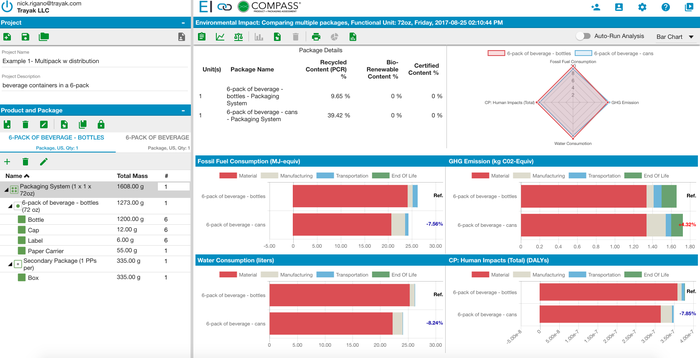The Sustainable Packaging Coalition saw a need for a tool that could provide environmental feedback in the early design phases.

For the past decade, a life-cycle assessment (LCA) tool has been in development to help package designers and engineers incorporate environmental feedback in the early design phases. Today, the product has evolved into a vital part of a platform of standalone and embedded solutions that allows companies to operationalize their sustainability goals.
COMPASS (Comparative Packaging Assessment) is a cloud-based tool that uses LCA to provide impacts associated with the sourcing, manufacturing, distribution, use, and end of life of a package. COMPASS uses industry average lifecycle data for packaging materials and processes to allow for comparisons of multiple scenarios.
“Packaging designers and decision-makers can be overloaded with the number of sustainability characteristics they're supposed to take into account,” says Adam Gendell, associate director of the Sustainable Packaging Coalition (SPC) based in Charlottesville, Va. “They're supposed to make packaging that fits with two sustainability frameworks: first, the circular economy, which says packaging shouldn't use non-renewable virgin materials and should be effectively recovered at its end-of-life; and second, sustainable materials management (SMM), which says packaging should incur the lowest possible environmental impacts from the extraction of raw materials through to the end of its life cycle.”
COMPASS helps quantify those environmental impacts that are important to the SMM framework.
“It helps us understand greenhouse gas emissions, water consumption, fossil fuel consumption, and other environmental impacts,” says Gendell. “It’s not intended to tell you everything about the sustainability of a package design, but it's a powerful tool to have in the toolbox.”
Ten years ago, there was no tool available that focused specifically on packaging. COMPASS was created to put the power of LCA in the hands of package designers.
The SPC saw a need for a tool that could provide environmental feedback in the early design phases. A survey of available lifecycle data was launched, new industry databases were created with the help of Walmart and the Environmental Protection Agency, and metrics were developed by a group of 12 key stakeholders from across the packaging supply chain.
“The (SPC) was the first organization to provide an answer to the question, ‘What is sustainable packaging?’ and once we had a visionary framework for what sustainable packaging would (look like), our members wanted to actualize the philosophy and measure their progress towards more sustainable packaging,” says Gendell. “Some parts are easy. You don't need to use life cycle assessment to understand whether a package uses responsibly sourced materials, or if it can be recycled at its end-of-life. But to understand something like a carbon footprint, LCA is needed.”
As sustainability initiatives continue to evolve, pressure has been put on packaging designers and engineers to align their designs with corporate sustainability initiatives. The tool, officially launched in 2011, has adapted to these changes.
“COMPASS has undergone constant development since its launch in 2011 to streamline the most common use cases for package engineers so that sustainability assessment could play a natural role in the design process,” says Nick Rigano, marketing specialist for Mason, Ohio-based Trayak, the original developer of the tool that now owns it.
Additional functionalities and user interface improvements have been added to the tool based on feedback from users and SPC members. Lifecycle data is constantly updated when it becomes available and as new materials are developed.
COMPASS can model primary packaging (the package that holds the product), secondary packaging (the business-to-business packaging that holds the primary packaging), transport packaging (like pallets and stretch wrap), and transportation processes, so that a COMPASS user can understand the environmental implications of a change to any part of a packaging system.
Now, COMPASS is part of Trayak's EcoImpact platform, which allows the user to incorporate their own proprietary data, link with product sustainability profiles, and weight different environmental indicators to create a custom scorecard.
“The COMPASS tool is a vital part of this platform and now allows companies to incorporate proprietary materials and custom metrics," Rigano says. "
EcoImpact is Trayak’s platform of standalone and fully integrated solutions designed to operationalize companies’ sustainability goals.
“The (SPC) sees great value in the development of the EcoImpact platform and we believe that it supports a robust environmental vision for the future of the packaging industry," says Nina Goodrich, director of the SPC and executive director of GreenBlue. “This platform will allow our member companies to further optimize packages for sustainability while aligning designs with corporate sustainability goals.”
According to Gendell, the use of LCA and the COMPASS tool will continue to grow and evolve.
“Industry interest in sustainable packaging is growing at a healthy pace. Packaging decision-makers are becoming more sophisticated in their understanding of the environmental trade-offs that accompany packaging decisions, and companies are becoming more aggressive in their goals and pursuits for packaging,” he says. “I think we'll see the use of LCA become more widespread and I know COMPASS and the EcoImpact platform will continue to grow and evolve to become more flexible and customizable so that companies can integrate it with the rest of their decision-making processes.”


About the Author(s)
You May Also Like


